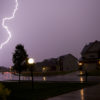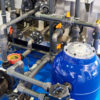The key to pool safety is correct water chemistry. There are two elements involved here, which are sanitation and overall water balance. Pool Troopers wants to help you understand the concept of keeping the pool water balanced. At the same time, the company would like to share hints and pointers on how to maintain your swimming pool.
Water Balance Fundamentals-pH
Pool water is sensitive with many factors and variables affecting your water on a daily basis. You want to attain harmony by means of keeping the water balanced. Balanced water on the pH range, which measures the acidity or basic nature of water, is achieved when the pH level of the water is between 7.2 and 8.0, where the magic number is 7.5.
If you take a look at the pH scale, these numbers are above the neutral level. Keeping the water balanced involves three ingredients:
1. The water’s pH level
2. Calcium Hardness
3. Alkalinity
First, the pH level, as mentioned, should be from 7.2 to 8.0. Some sources use the range from 7.4 to 7.6 as the ideal range for swimmers. Keeping it at these levels will help you get balanced and safe water that you and your family can comfortably swim in.
It is important to note that just because there is a proper pH reading in your pool right now does not mean it will have a proper reading in 30 minutes from now. That is because pH is basically unstable on its own, anything that touches your pool water can potentially affect the pH level. Some examples of everyday things that can affect pH in the pool include swimmers, fill water, yard chemicals and rain. TO combat this fluctuation a balanced pool must have a proper amount of Alkalinity which measures a waters ability to withstand changes to pH. So balance is important, more on alkalinity later.
As the pH level goes down, it means the pool water is acidic. On the other hand, it is basic when the pH level is high. To further understand how important pH is, take your tears as an example. Human tears range from 6.5-7.6 and average at pH neutral 7.0. If they were acidic or low in pH, your eyes will burn when you cry. Meanwhile, if the pH of tears were high, your eyes will dry out.
You need to make sure the pH of your pool is at the right level, especially during certain seasons. A pH increaser and decreaser are great chemicals to have on hand. You already know that adjusting the pH is necessary to maintain the pool’s water chemistry. Therefore, these two chemicals will help when the levels fluctuate from time to time.
Pool Troopers offers chemical services, so you do not have to do this task yourself. Nevertheless, it is still important to understand the basics of chemistry.
Calcium Hardness and Alkalinity
Calcium hardness target levels depend on the type of pool you have. However, it is best to keep it around 200 to 400 ppm (parts per million) when the source water is rain or surface lake water. In areas out west in the Colorado River water system keeping Calcium Hardness below 1500 ppm is important.
Water is always striving to reach a chemical equilibrium with its surroundings. If those surroundings are your basic pool finish and the calcium content of the pool is lower than the surrounding cement of your finish the water will leach Calcium from the finish. If you do not have a cementitious pool finish (fiberglass, tile, or vinyl pool) then keeping the Calcium Hardness at the lower end of the range or even slightly below is ok.
For plaster pools, it is necessary to keep calcium hardness at an optimal level to protect the walls of the pool and to help contribute to Alkalinity. Too much calcium hardness in your water, on the other hand, has some negative side effects. It is why you should keep it at the right level.
Be sure to check Calcium hardness at least twice a year and usually add calcium hardness only once before the beginning of the pool season. It should only dissipate through water loss so it may not be needed, do not overdo it. You only have to make certain that it stays within the right range. If it is too high, having a trained pool professional dilute your pool and fill it with fresh water is a good solution.
As for Alkalinity, it is advised to keep it at 80 to 150 ppm. Alkalinity buffers the pH level of the water protecting it from the sudden change. Therefore, it aids in keeping the levels from moving up and down at a drastic pace. The pH buffer absorbs certain changes before they can affect the pH.
How Can You Keep the Pool Water Balanced?
New pool owners need to keep an eye on the pH and alkalinity of their swimming pools at least once a week, and before every use until they know how their pool reacts to its environment and rain events. Later on, it will be much easier to gain a sense of how the water in your pool works. Test strips or a whole kit can give you an idea as to how you can keep the pool water balanced. Make sure to store test kits in cool dry locations, and replace the reagents at least every 6-12 months.
In addition to keeping an eye on the total alkalinity of the water, its pH and the calcium Hardness you will need to know the Stabilizer level. The stabilizer is Isocyanuric Acid or CA or CYA and just like Alkalinity does for pH, CYA helps your pool sanitizer stay intact and persevere through the degradation of UV light. These four are essential aspects of determining the water balance of your swimming pool. In general, when the water is balanced for human swimmers, it means the pool is safe from corrosion and slightly in the scale forming zone of pH, the pool finish is protected and the chlorine is stabilized against UV degradation.
Sanitizing the Pool
Chlorine or rather Chlorinating Compounds are the most known sanitizer for swimming pools. It is important to understand the Chlorinating Compound you will be using and its effect on pH in the pool. If you add an acidic sanitizer such as TriChlor Tabs, you will need to “balance” their addition to the pool by adding a chemical to buffer the pH and Alkalinity up. However, if your sanitizer is Sodium Hypochlorite Bleach, often improperly referred to as “Liquid Chlorine” which it is not, you are adding a strong base to the pool and you will need to balance the reaction by adding pool acid.
Your pools test kit should measure Total and Free Chlorine. When measured your Total Chlorine reading should be 2-4 ppm ideal being 3 ppm. Free Chlorine should exactly equal Total Chlorine in a swim safe pool. If Total Chlorine is higher than Free Chlorine it signifies the presence of combined chlorine and you may notice or experience harsh odors coming off the pool and swimmer eye and skin irritation. Stop swimming and please consult references for super-chlorinating the pool if this is the case.
Chlorinating Compounds are extremely efficient in killing bacteria and algae. At the same time, using it is cost-effective because it works and you do not have to keep redoing the sanitation job.
Chlorinating compounds for your pool come in various forms. Typically, you will find them as tablets, liquids, powders or granular forms. Pool Troopers use all these and further offers the free use of our salt chlorine generators providing you the best most luxurious safe swimming experience.
When purchasing chlorinating compounds, you should look at the listed active ingredients. Some product such as Dichlor or Trichlor are stabilized already- they have CYA in them. Therefore, if they are exposed to the sun, the sun’s UV rays will not eat up the chemical – or at least the process is slowed down. However, they are less effective as “shocking agents” for your pool than Chlorinating Compounds without stabilizer added.
Other Water Chemistry Maintenance Tips from Pool Troopers
Here are other simple things to know in maintaining your pool’s chemicals:
• High pH: A quick solution to high pH is to add a small amount of Pool Acid which is dilute Hydrochloric Acid under the trade name Muriatic Acid. Test the water after six hours or so. Make sure that you do not stop filtration. Readjust the pH level if it is still needed. This careful method helps prevent bouncing the water pH.
• True pH bounce: If you are having a real issue with pH bounces, it is typically due to low alkalinity of the water. You will need to readjust its level upward by adding Sodium Bi-Carbonate. Yes baking soda, but buy it in the big bags, not the little box.
• Burning eyes: If the swimmers are complaining about having burning eyes whenever they swim in your pool, you should not automatically blame it on the chlorine levels of the water. In truth, the real culprit here is probably the pH level. If it is high or low, it can cause a problem. Remember to also check the total and free chlorine readings.
• Testing and retesting: It is recommended that homeowners test the pool water for at least once a week or more frequently for pools that get heavy use. The test and following up with adjustments ensures that water is balanced. Maintain the chlorine levels, which should be at two to four ppm at least in the Sun Belt states. If you can keep this number, it will aid you in having a problem-free swimming season.
Find out more about how Pool Troopers can help you enjoy a better swimming experience. Contact the experts today.




